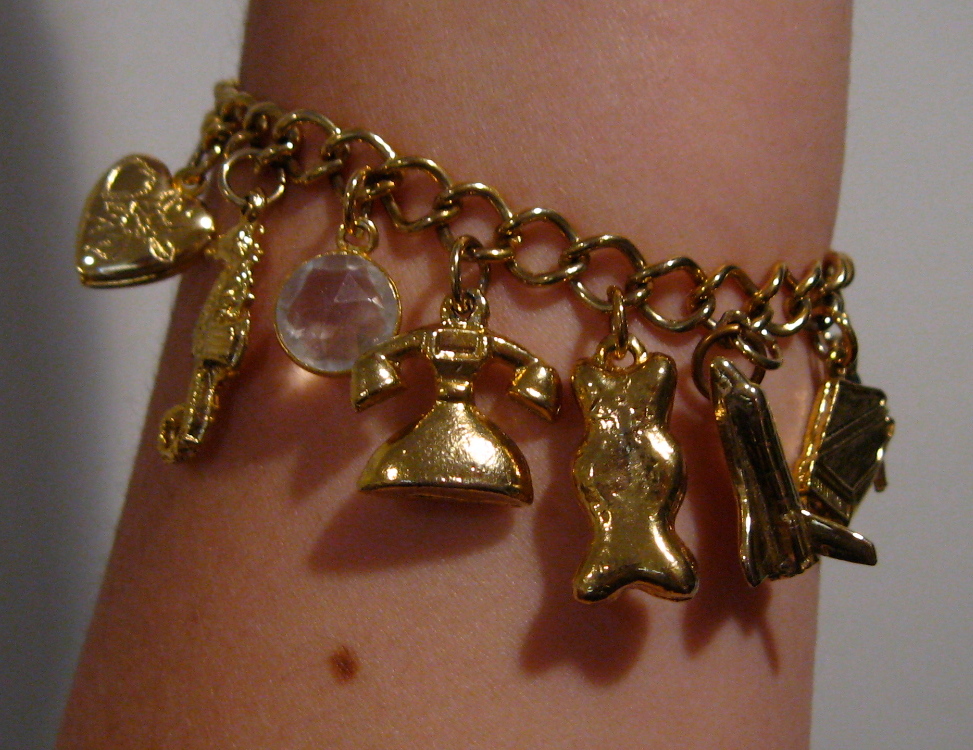 CS writes: "My wife's mother recently passed away after a long terrible bout with MS. Prior to her being debilitated with this disease, my wife tells me that she was into new age type beliefs. . .
CS writes: "My wife's mother recently passed away after a long terrible bout with MS. Prior to her being debilitated with this disease, my wife tells me that she was into new age type beliefs. . ."Among the keepsakes that my wife has inherited was a charm bracelet that seems more decorative than anything. It is more of the Tiffany's and Co. type of charm bracelet rather than something looking like it came from a witch doctor. The charms dangling off the bracelet seem to be of things that her mother was interested in, such as a tiny violin, as she played violin when she was younger.
"My questions... are all charm bracelets problematic? Would a charm bracelet of this kind qualify with the prohibition found in the Catechism (#2117)?"
The only way to know if your mother-in-law's charm bracelet falls into the category of a superstitious charm such as what is referenced in No. 2117 in the Catechism would be to know how she was using it.
But before I get into that, for the sake of our readers, let's take a look at paragraph 2117 of the Catechism:
"All practices of magic or sorcery, by which one attempts to tame occult powers, so as to place them at one's service and have a supernatural power over others - even if this were for the sake of restoring their health - are gravely contrary to the virtue of religion. These practices are even more to be condemned when accompanied by the intention of harming someone, or when they have recourse to the intervention of demons. Wearing charms is also reprehensible. Spiritism often implies divination or magical practices; the Church for her part warns the faithful against it. Recourse to so-called traditional cures does not justify either the invocation of evil powers or the exploitation of another's credulity" [emphasis added].
The kind of charm referenced in this paragraph is what is better known as a "good luck charm" such as a rabbits foot, Hamsa Hand, or lucky coin. The kind of charms found on today's charm bracelets tend to be representations of major events in life such as a wedding or anniversary, of one's special interests such as animals or sewing machines or painter's palette, etc. They are worn more as a kind of personal history than as a superstition.
But having said all that, you might be surprised to know that today's charm bracelets have roots in ancient superstitions. The first known charm bracelets were worn by the ancient Egyptians to denote their social status in this life and as an aid to achieving the same status in the next. Medieval charm bracelets were thought to possess special protective powers or curses and were thought to bring good luck and good fortune to the wearer.
From that time on, the popularity of these bracelets ebbed and flowed. They were popular during the Renaissance era but faded away until Queen Victoria resurrected them, but without any superstitious trappings. Hers were a definite fashion statement and sported the family crest, interesting trinkets and lockets as well as costly jewels. She had such a love for this particular piece of jewelry that she was dubbed "The Charm Queen."
They were popular during World War II because it was easy for a soldier to bring his gal a gift of a small charm from overseas because it could be carried home in his pocket. They remained popular until the 1950s when they fell into obscurity again, this time not coming back until the turn of the 21st century when these bracelets, which some refer to as a "history on a wrist," once again became the rage.
Chances are, this is the type of charm bracelet your mother-in-law owned. I see no modern evidence of these bracelets being worn for superstitious purposes, but that's not to say someone can't use them in this way. A person can turn just about anything - even blessed items - into objects of superstition because this all depends on the interior disposition of the user.
The Catechism teaches that "Superstition is the deviation of religious feeling and of the practices this feeling imposes. It can even affect the worship we offer the true God, e.g., when one attributes an importance in some way magical to certain practices otherwise lawful or necessary. To attribute the efficacy of prayers or of sacramental signs to their mere external performance, apart from the interior dispositions that they demand, is to fall into superstition" (No. 2111).
For example, it would be superstitious for a woman to put a statue of the Blessed Mother in a window because she believes the statue will somehow effect the weather. This would be to attribute the efficacy of devotion to Our Lady to the mere motion of putting a statue in the window and would therefore constitute superstition. A person with the correct interior disposition would put a statue of the Blessed Mother in the window and pray for her intercession for good weather, thus assigning the power to effect the weather to Our Lady's intercession, not to the placement of the statue.
In other words, it depends on how your mother-in-law was using her charm bracelet. If she wore it as a fashion statement, there's no problem with it. But if she wore it because she believed the charms brought her good luck, then it would have been used for a superstitious purpose.
However, even if she was using it for a superstitious purpose, the charm bracelet itself is nothing more than an inanimate object and there would be no risk in your keeping it as a memento of your loved one.
© All Rights Reserved, Living His Life Abundantly®/Women of Grace® http://www.womenofgrace.com
